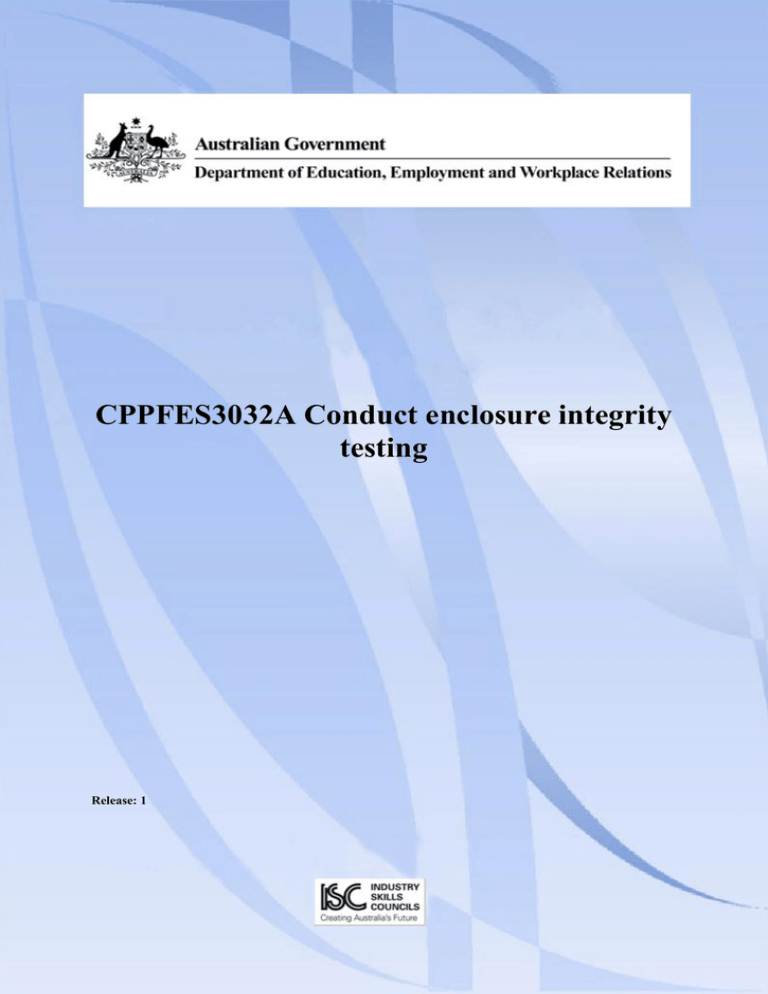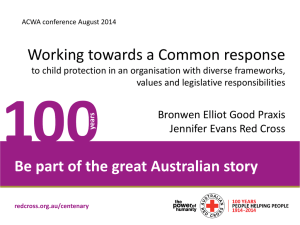CPPFES3032A Conduct enclosure integrity testing
advertisement

CPPFES3032A Conduct enclosure integrity testing Release: 1 CPPFES3032A Conduct enclosure integrity testing Date this document was generated: 26 May 2012 CPPFES3032A Conduct enclosure integrity testing Modification History New unit No equivalent unit Unit Descriptor This unit of competency specifies the outcomes required to test the integrity of enclosures protected by total flooding gaseous suppression systems. The unit covers working safely, conducting compliance tests using appropriate equipment and procedures, and visually inspecting and identifying non-compliance defects. It involves satisfying mandatory reporting requirements as well as general isolations and resetting associated with a gaseous agent fire protection system. Application of the Unit This unit of competency supports fire protection technicians responsible for functional testing of fire protection systems. Individuals operate within the scope of their defined roles and responsibilities and perform the functional tests as part of their work duties and according to work procedures and Australian standards, to verify that equipment functions as intended. Licensing/Regulatory Information The unit must be applied strictly according to relevant state or territory legislative and industry requirements. Different states and territories may have regulatory mechanisms that apply to this unit. Candidates are advised to check for regulatory limitations. Pre-Requisites Not applicable. Employability Skills Information This unit contains employability skills. Approved © Commonwealth of Australia, 2012 Page 2 of 10 Construction & Property Services Industry Skills Council CPPFES3032A Conduct enclosure integrity testing Date this document was generated: 26 May 2012 Elements and Performance Criteria Pre-Content Elements describe the essential outcomes of a unit of competency. Performance criteria describe the performance needed to demonstrate achievement of the element. Where bold italicised text is used, further information is detailed in the required skills and knowledge section and the range statement. Assessment of performance is to be consistent with the evidence guide. Elements and Performance Criteria 1 2 Apply compliance 1.1 requirements to service operations. Conduct inspections and isolations. Approved © Commonwealth of Australia, 2012 Legislative and industry requirements are interpreted, confirmed and applied to organisational requirements and service operations. 1.2 Location and equipment are checked for compliance with legislative and industry requirements, and action is taken according to organisational requirements. 1.3 Preparations are made for conducting functional inspection and testing according to organisational requirements. 2.1 Workplace procedures are followed and risk control measures applied when inspecting and isolating gaseous agent fire-suppression system. 2.2 Gaseous agent fire-suppression system controls are identified and functions determined with reference to manufacturers’ instructions in order to conduct enclosure integrity testing according to legislative and industry requirements. 2.3 Plant and other system interfaces to be isolated are identified. 2.4 Visual inspections and checks are conducted according to organisational requirements. 2.5 Integrity testing equipment is set up in readiness to conduct tests according to manufacturers’ procedures and site configuration. Page 3 of 10 Construction & Property Services Industry Skills Council CPPFES3032A Conduct enclosure integrity testing 3 Date this document was generated: 26 May 2012 Conduct testing 3.1 and record results. Test methods are implemented according to legislative and industry requirements. 3.2 Enclosure integrity testing procedures are conducted to verify that system functions as intended according to organisational requirements. 3.3 Test results are compared with legislative and industry requirements. 3.4 Results are documented according to legislative and industry requirements. 3.5 Report is forwarded to persons for action according to legislative and industry requirements. 3.6 System is reinstated according to organisational requirements. Approved © Commonwealth of Australia, 2012 Page 4 of 10 Construction & Property Services Industry Skills Council CPPFES3032A Conduct enclosure integrity testing Date this document was generated: 26 May 2012 Required Skills and Knowledge This section describes the skills and knowledge required for this unit. Required skills customer service skills language, literacy and numeracy skills to: communicate with others clearly and concisely, verbally and in writing read and comply with work instructions and specifications read, calculate and record measurements record and report information neatly and legibly technical skills to operate valves, switches and levers to isolate and reset systems to normal operation planning and organising skills to: estimate time to complete activities prioritise tasks interpersonal skills to relate to people from a range of social and cultural backgrounds skills to work safely when: applying workplace housekeeping procedures conducting enclosure integrity testing Required knowledge features of gaseous agent fire-suppression systems, testing equipment and testing parameters, including: gaseous agent hold time general operation of a fan test unit installation of equipment operation of equipment pass or fail against AS 4214 Gaseous fire extinguishing systems (10 minute/100mm against highest protected risk) key features of legislation, regulations and codes applicable to conducting tests terminology used in relation to integrity testing, such as: agent loss agent recirculation descending interface (height) highest protected risk (minimum protected equipment height) retention time total leakage area Approved © Commonwealth of Australia, 2012 Page 5 of 10 Construction & Property Services Industry Skills Council CPPFES3032A Conduct enclosure integrity testing Date this document was generated: 26 May 2012 upper and lower leaks Approved © Commonwealth of Australia, 2012 Page 6 of 10 Construction & Property Services Industry Skills Council CPPFES3032A Conduct enclosure integrity testing Date this document was generated: 26 May 2012 Evidence Guide The evidence guide provides advice on assessment and must be read in conjunction with the performance criteria, required skills and knowledge, range statement and the Assessment Guidelines for the Training Package. Overview of assessment This unit of competency could be assessed by observation of practical demonstration on customer premises or in simulated workplace environment. Critical aspects for assessment and evidence required to demonstrate competency in this unit A person who demonstrates competency in this unit must be able to provide evidence of the required skills and knowledge specified in this unit. In particular the person should demonstrate the ability to conduct tests on enclosures where total flooding gaseous agent protection is installed and a doorway is fitted. Enclosures should include: computer room electrical switch room machinery space in a vessel. Note: Tests must be conducted according to the current Australian standard relevant to inspection, test and preventive maintenance of the gaseous agent fire-suppression system. Context of and specific resources for assessment Assessment of essential underpinning knowledge may be conducted in an off-site context. It is to comply with relevant regulatory or Australian standards’ requirements. Resource implications for assessment include: Method of assessment Assessment methods must: Guidance information for assessment Approved © Commonwealth of Australia, 2012 fan integrity-testing equipment suitable enclosures to demonstrate required test conditions. satisfy the endorsed Assessment Guidelines of the Property Services Training Package include direct observation of tasks in real or simulated work conditions, with questioning to confirm the ability to consistently identify and correctly interpret the essential underpinning knowledge required for practical application reinforce the integration of employability skills with workplace tasks and job roles confirm that competency is verified and able to be transferred to other circumstances and environments. Reasonable adjustments for people with disabilities must be made to assessment processes where required. This could include access to modified equipment and other physical resources, and the provision Page 7 of 10 Construction & Property Services Industry Skills Council CPPFES3032A Conduct enclosure integrity testing Date this document was generated: 26 May 2012 of appropriate assessment support. Assessment processes and techniques should as far as is practical take into account the language, literacy and numeracy capacity of the candidate in relation to the competency being assessed. This unit could be assessed on its own or in combination with other units relevant to the job function. Range Statement The range statement relates to the unit of competency as a whole. It allows for different work environments and situations that may affect performance. Bold italicised wording, if used in the performance criteria, is detailed below. Essential operating conditions that may be present with training and assessment (depending on the work situation, needs of the candidate, accessibility of the item, and local industry and regional contexts) may also be included. Legislative and industry requirements may include: Organisational requirements may be located in quality assurance and procedures manuals relating to: Approved © Commonwealth of Australia, 2012 dangerous goods regulations environmental regulations extinguishing agent handling licences (EAHL) licensing arrangements occupational health and safety (OHS) legislation, regulations and codes relevant commonwealth and state or territory building Acts, regulations and codes, such as Building Code of Australia (BCA) relevant Australian standards, such as: AS 1851 Maintenance of fire protection systems and equipment AS 4214 Gaseous fire extinguishing systems note: Australian standards are frequently revised and users must always check for currency and amendments other relevant legislation relating to fire protection equipment, including: international shipping codes marine codes for different Australian States. customer-specific contractual requirements documentation and information systems and processes legal and organisational policy and guidelines legislation relevant to service operation personnel practices and guidelines outlining work roles, responsibilities and delegations use of electronic job scheduling and communication devices. Page 8 of 10 Construction & Property Services Industry Skills Council CPPFES3032A Conduct enclosure integrity testing Checking for compliance may include: Action may include: Gaseous agent fire-suppression systems may include: Enclosures may include: Approved © Commonwealth of Australia, 2012 Date this document was generated: 26 May 2012 providing the coverage and protection needed to meet original design and performance requirements suitability for fire hazard or risk being protected, whether change has occurred in use of the protected area since equipment or system was installed or last modified reviewing documentation to verify that installed systems comply with legislative and industry requirements, such as: building’s essential services or fire safety measures listing environmental regulations relevant commonwealth and state or territory building Acts, regulations and codes relevant Australian standards listed on essential service listing undertaking commissioning tests detailed in Australian standards and manufacturers’ documentation to verify performance of an installed, repaired or altered piece of equipment or system applying inspection, test and survey requirements according to Australian standards. advising customer documenting non-compliance making equipment safe reporting, as required. total flood systems which use a variety of extinguishing agents, such as: inert gaseous fire-extinguishing agents liquefied gaseous agent, such as carbon dioxide synthetic gaseous fire-extinguishing agents (note: EAHL is required) major components of these systems may include: actuators alarm system devices automatic fire detection devices containers of extinguishant agent local control stations nozzles connected to the pipework pipework connected to extinguishant containers warning devices and signs at entry points to protected space. electrical switch rooms rooms where total flooding gaseous agent protection is installed and a suitable doorway is fitted, such as: computer rooms machinery spaces in vessels. Page 9 of 10 Construction & Property Services Industry Skills Council CPPFES3032A Conduct enclosure integrity testing System interfaces may include: Integrity testing equipment may include: Test methods may include: Date this document was generated: 26 May 2012 components, such as: directional valves pressure switches tamper switches devices that operate signals between the gaseous fire-suppression system and other services, such as: building heating, ventilation and cooling (HVAC) services fire brigade monitoring providers other life safety systems, such as: alarm systems fire detection systems warning systems. floor panel lifter for false floors measuring devices and tapes proprietary equipment and software smoke pencils step ladders temporary patching material. identifying gaseous agent in use calculating mass of gaseous agent identifying return air flow path measuring room and calculating room volume fitting fan unit to door frame proprietary equipment procedures identifying mechanical ventilation, including air conditioning in room identifying agent retention mode: descending interface recirculating. Unit Sector(s) Fire protection equipment Custom Content Section Not applicable. Approved © Commonwealth of Australia, 2012 Page 10 of 10 Construction & Property Services Industry Skills Council


